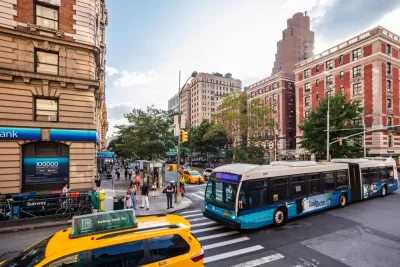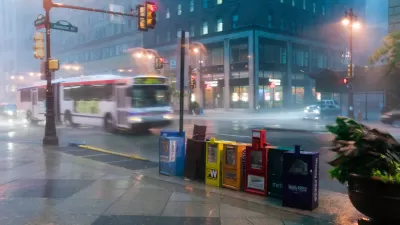Pre-signals offer the benefit of a dedicated lane on smaller streets that can't accommodate a dedicated bus lane.

Faster buses attract more riders and add capacity by speeding up travel, but sometimes street geometry doesn't accommodate dedicated bus lanes. "The democratizing force is a dedicated lane, which can allow buses to carry upwards of four times as many travelers per hour than a general traffic lane," reports Laura Bliss in CityLab.
When a street cannot accommodate a dedicated bus lane, as when there is traffic in both directions, no parking, and the street needs to remain two-way, one option to speed up buses is pre-signals. These traffic signals, currently in use in the United Kingdom and Switzerland, are placed before intersections and can stop traffic in both directions to let buses pass. These signals stop the cars, then the bus pulls into the lane formerly used for oncoming traffic to pass, as pictured in this animation.
"According to the simulations that the authors ran, the time-savings appears to be significant. Pre-signals can save bus travelers 5 to 7 seconds of delay per intersection at uncongested intersections, and up to 30 seconds of delay at congested intersections," Bliss reports.
FULL STORY: When is a Dedicated Bus Lane Not a Dedicated Bus Lane?

Alabama: Trump Terminates Settlements for Black Communities Harmed By Raw Sewage
Trump deemed the landmark civil rights agreement “illegal DEI and environmental justice policy.”

Planetizen Federal Action Tracker
A weekly monitor of how Trump’s orders and actions are impacting planners and planning in America.

The 120 Year Old Tiny Home Villages That Sheltered San Francisco’s Earthquake Refugees
More than a century ago, San Francisco mobilized to house thousands of residents displaced by the 1906 earthquake. Could their strategy offer a model for the present?

In Both Crashes and Crime, Public Transportation is Far Safer than Driving
Contrary to popular assumptions, public transportation has far lower crash and crime rates than automobile travel. For safer communities, improve and encourage transit travel.

Report: Zoning Reforms Should Complement Nashville’s Ambitious Transit Plan
Without reform, restrictive zoning codes will limit the impact of the city’s planned transit expansion and could exclude some of the residents who depend on transit the most.

Judge Orders Release of Frozen IRA, IIJA Funding
The decision is a victory for environmental groups who charged that freezing funds for critical infrastructure and disaster response programs caused “real and irreparable harm” to communities.
Urban Design for Planners 1: Software Tools
This six-course series explores essential urban design concepts using open source software and equips planners with the tools they need to participate fully in the urban design process.
Planning for Universal Design
Learn the tools for implementing Universal Design in planning regulations.
Clanton & Associates, Inc.
Jessamine County Fiscal Court
Institute for Housing and Urban Development Studies (IHS)
City of Grandview
Harvard GSD Executive Education
Toledo-Lucas County Plan Commissions
Salt Lake City
NYU Wagner Graduate School of Public Service





























